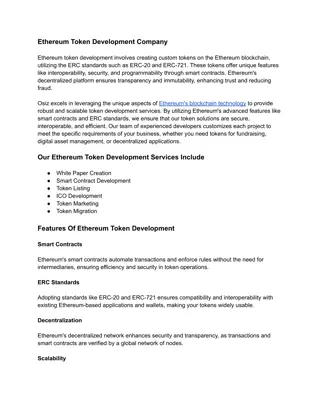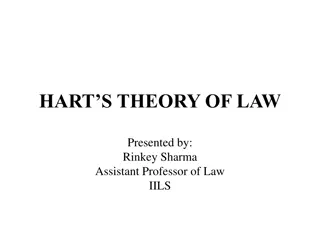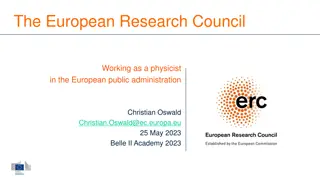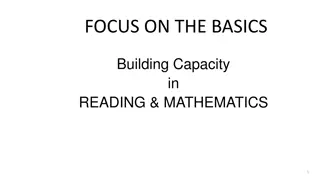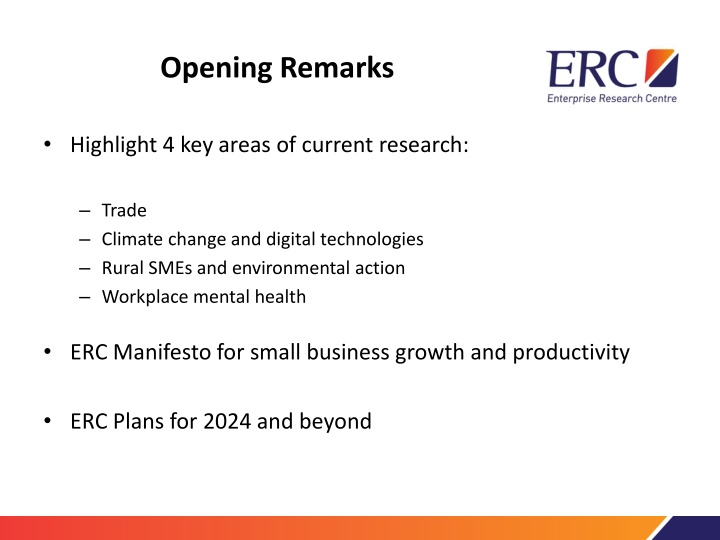
Insights on Small Business Dynamics and Productivity in the UK
Explore key areas of current research, including trade, climate change, digital technologies, rural SMEs, workplace mental health, and the ERC manifesto for small business growth. Learn about the decline in business dynamism in the UK, job allocation rates, and the need for a new focus on small business policy. Discover the concept of "Productivity Heroes" among SMEs and the trends in their growth and revenue. Find out how enterprise policy can support these firms to address long-standing productivity challenges in the UK.
Download Presentation

Please find below an Image/Link to download the presentation.
The content on the website is provided AS IS for your information and personal use only. It may not be sold, licensed, or shared on other websites without obtaining consent from the author. If you encounter any issues during the download, it is possible that the publisher has removed the file from their server.
You are allowed to download the files provided on this website for personal or commercial use, subject to the condition that they are used lawfully. All files are the property of their respective owners.
The content on the website is provided AS IS for your information and personal use only. It may not be sold, licensed, or shared on other websites without obtaining consent from the author.
E N D
Presentation Transcript
Opening Remarks Highlight 4 key areas of current research: Trade Climate change and digital technologies Rural SMEs and environmental action Workplace mental health ERC Manifesto for small business growth and productivity ERC Plans for 2024 and beyond
Business Dynamism in the UK Business Dynamism in long-term decline since 1998 - Job Allocation Rate (JAR) falling from 35% in 1998 to 22% in 2022 400,000 more established SMEs (3 years +) since 2010 but proportion registering growth in employment falling from 20% to 13% . and yet, business support in England currently in a state of transition.
Jobs, Turnover and Productivity Developing a new focus for small business policy in the UK Previous research by the ERC showed that there was a very poor correlation between jobs growth, increases in revenues and productivity gains in the UK business population. Panel study of 250k employer enterprises (2008-15) - only 5% of the firms studied managed to significantly increase turnover, jobs and productivity at the same time some 10,000 firms! The relationship between the growth of turnover and productivity was strong and positive, with 3 out of 4 firms that grew turnover also raising productivity.
Productivity Heroes We set out to investigate those firms that are registering productivity gains (i.e., turnover per employee) and are doing so while still creating jobs. These small businesses we call Productivity Heroes are defined as SMEs aged 3 years and over that are growing both their revenues and headcount but their revenues at a faster rate. The base population used to identify the number of Productivity Heroes is all surviving private sector SME employer enterprises (1-249 emps) in the UK in 2021-22 which are at least 3 years of age - i.e., not start-ups 1.22m enterprises.
Productivity Heroes - Trends So, out of a total of 453,231 firms that had increased their productivity we can see that there is a small group of SMEs (8% or 36,298 firms) aged 3 years and over within this total that are creating jobs by an average of 29% growth but growing revenue even more rapidly by an average of 196% Year No. of SMEs No. and % of No. and % of businesses achieving Productivity (3 years and productivity growth over) Heroes1 676k 347k - 51.3% 4.5% (15,622) 2000-01 825k 449k - 54.4% 8.8% (39,245) 2007-08 882k 358k - 40.7% 6.6% (23,740) 2010-11 1.13m 557k - 49.2% 6.7% (37,125) 2018-19 1.22m 453k - 37.0% 8.0% (36,298) 2021-22
Productivity Heroes what next? Enterprise policy should place a central focus on this newly identified small group of firms to provide some evidence on how to address the UK s long-standing productivity problem and with it the long tail of unproductive mainly small firms. Next stage is to track their performance over time to investigate the persistence of their productivity gains over time and indeed, looking back, identify in what year the 2021-22 cohort of Productivity Heroes first met the criteria. Engage in qualitative research to understand the drivers of these productivity gains especially leaders mindset and ambition Read more Hart and Bonner (2024) Productivity Puzzles, Long Tails and Productivity Heroes: developing a new focus for small business policy in the UK , ERC Insight Paper, February 2024.








